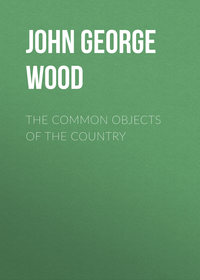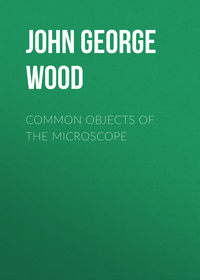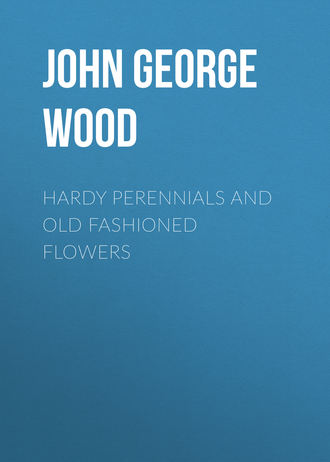 полная версия
полная версияHardy Perennials and Old Fashioned Flowers
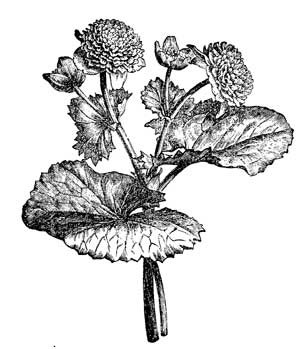
Fig. 22. Calthus Palustris Flore-Pleno.
(One-half natural size.)
It has long fleshy roots, which allows of its being transplanted at any time, early spring being the best, to increase it. The crowns should be divided every three years, when there will be found to be ample roots to each one.
Flowering period, April to June.
Calystegia Pubescens Flore-pleno
Nat. Ord. ConvolvulaceæThis double Convolvulus is a somewhat recent introduction from China; it is hardy and perennial. So distinct are its large flesh-coloured flowers that they are often taken at the first glance, when cut, for double pyrethrums or chrysanthemums, but, seen in connection with the plant, the form of foliage and climbing or twining habit of the bindweed soon enable the most casual observer of flowers to recognise its genus.
The flowers are 2in. to 3in. across, petals long, narrow, wavy, and reflexed; these are well held together by the five-parted calyx, further supported by a bract of two small but stout leaves. The flower stalks are round and wiry, 3in. or 4in. long; they are produced all along the twining stems, which are only of the moderate length of 5ft. or 6ft. The leaves are of the well-known Convolvulus form.
I find it a good plan to grow this subject amongst tall and early flowering plants, such as lupins, foxgloves, and lilies, the old stems of which form ample supports for the climber; moreover, they are rendered less unsightly from being thus furnished anew with leaf and flower, even though not their own. Another method is in early summer to place a short twiggy branch over the pushing growths; it will soon become covered, and if not too large, the ends of the shoots will slightly outgrow the twigs and hang down in a pleasing manner. The plant should be started in light sandy loam and have a warm situation, otherwise flowers will be scarce and the whole specimen have a weedy appearance. When once it becomes established, it will be found to spread rapidly by means of its running roots, which, unless checked, will soon become a pest. I simply pull out all growths except such as shoot up in the desired position, and so continue to treat them as weeds throughout the growing season. Stems furnished with flowers a yard or more long, in a cut state, make rich festoons; single blooms (the smaller ones) look well as "buttonholes," being neat and effective, without gaudiness. I ought to state that a succession of flowers is kept up for fully three months; this fact adds not a little to the value of this handsome flesh-coloured bloomer. Roots may be transplanted at any time; the smallest piece will produce a blooming plant the first season, if put into a proper soil and situation.
Flowering period, July to September.
Campanula Grandis
Great Bellflower; Nat. Ord. CampanulaceæA hardy herbaceous perennial from Siberia, growing to a height of 3ft. Its flowers are large, bright, and numerous; well-established clumps will present masses of bloom for more than a month with average weather. As a large showy subject there are few plants more reliable, or that can in any way excel it, more especially for town gardens. It is a rampant grower, quickly covering large spaces by means of its progressive roots; in gardens or collections where it can only be allowed a limited space, the running habit of the roots will doubtless prove troublesome, and often such free growers, however handsome they may be otherwise, are esteemed common, which should not be. The proper thing to do would be to give these vigorous and fine flowering subjects such quarters as will allow them their natural and unrestrained development.
The flowers of C. grandis are more than 1in. across the corolla, the five segments being large and bluntly pointed, of a transparent purple-blue colour, and very enduring; they are arranged on short stalks, which issue from the strong upright stems. They form little tufts of bloom at every joint for a length of nearly 2ft.; the succession, too, is well kept up. Buds continue to form long after the earliest have opened. The leaves are 4in. to 8in. long and ¾in. wide, lance-shaped, stalkless, and finely toothed. They are arranged in round tufts on the unproductive crowns, and they remain green throughout the winter.
As regards soil, any kind will do; neither is the question of position of any moment beyond the precaution which should be taken against its encroachments on smaller subjects. In the partial shade of shrubs it not only flowers well but proves very effective. Useful as this plant is in the garden, it becomes far more so in a cut state. When it is needful to make up a bold vase or basket of flowers for room decoration, it can be quickly and effectively done by a liberal use of its long, leafy, but well-bloomed spikes; five or six of them, 2ft. to 3ft. long, based with a few large roses, pæonies, or sprays of thalictrum, make a noble ornament for the table, hall, or sideboard, and it is not one of the least useful flowers for trays or dishes when cut short. Propagated by division at any time, the parts may be planted at once in their blooming quarters.
Flowering period, June and July.
Campanula Latifolia
Broad-leaved Bellflower; Nat. Ord. CampanulaceæA British species, very much resembling C. grandis, but somewhat taller, and flowering a little earlier; the latter quality has induced me to mention it, as it offers a fine spike for cutting purposes before the above is ready.
Culture, uses, and propagation, the same as for C. grandis.
Flowering period, June and July.
Campanula Persicifolia
Peach-leaved Bellflower; Old Common Names, "Peach-bels" and "Steeple-bels"; Nat. Ord. CampanulaceæThis good "old-fashioned" perennial has had a place in English gardens for several hundred years; it is still justly and highly esteemed. It is a well-known plant, and as the specific name is descriptive of the leaves, I will only add a few words of Gerarde's respecting the flowers: "Alongst the stalke growe many flowers like bels, sometime white, and for the most part, of a faire blewe colour; but the bels are nothing so deepe as they of the other kindes, and these also are more delated and spred abroade then any of the reste." The varieties include single blue (type) and white, double blue, and different forms of double white.
In all cases the corolla is cup or broad bell shaped, and the flowers are sparingly produced on slightly foliaged stems, 18in. to 3ft. high; there are, however, such marked distinctions belonging to C. p. alba fl.-pl. in two forms that they deserve special notice; they are very desirable flowers, on the score of both quaintness and beauty. I will first notice the kind with two corollas, the inner bell of which will be more than an inch deep, and about the same in diameter. The outer corolla is much shorter, crumpled, rolled back, and somewhat marked with green, as if intermediate in its nature between the larger corolla and the calyx. The whole flower has a droll but pleasing form, and I have heard it not inaptly called "Grandmother's Frilled Cap." The other kind has five or more corollas, which are neatly arranged, each growing less as they approach the centre. In all, the segments are but slightly divided, though neatly formed; this flower is of the purest white and very beautiful, resembling a small double rose. It is one of the best flowers to be found at its season in the borders, and for cutting purposes I know none to surpass it; it is clean and durable. So much are the flowers esteemed, that the plant is often grown in pots for forcing and conservatory decoration, to which treatment it takes kindly.
In the open all the above varieties grow freely in any kind of garden soil, but if transplanted in the autumn into newly-dug quarters they will in every way prove more satisfactory; this is not necessary, but if cultivation means anything, it means we should adopt the best-known methods of treatment towards all the plants we grow, and certainly some of the above Bellflowers are deserving of all the care that flowers are worth.
Flowering period, July to September.
Campanula Pyramidalis
Pyramidal or Chimney Campanula; Nat. Ord. CampanulaceæThis herbaceous perennial is a very old flower in this country; it came from Carniola in the year 1594. It is very hardy, and for several months together it continues to produce its large lively blue flowers, beginning in July and lasting until stopped by frosts. At no time is it in finer form than in September; at the height of from 5ft. to 7ft. it proves richly effective amongst the blooming hollyhocks, where, as regards colour, it supplies the "missing link" (see Fig. 23).
The flowers are a light bright blue colour, and 1in. to 1½in. across. The corolla is bell-shaped, the five divisions being deeply cut, which allows the flower to expand well; the calyx is neat and smooth, the segments long and awl-shaped; the flower stalks are short, causing the numerous erect branches to be closely furnished with bloom during favourable weather. The leaves of the root are very large and stalked, of irregular shape, but for the most part broadly oval or lance-shaped. The edges are slightly toothed, having minute glands; those of the stems are much smaller, sessile, and long egg-shaped; all the foliage is smooth, and of a dark green colour; the main stems are very stout, and sometimes grow to the height of 7ft. Vigorous plants will send up several of these, from which a great number of small ones issue, all assuming an erect habit; blooming specimens are hardly anything else than a wand-like set of flowered stems, and though it is advisable to stake them, I have seen them bend and wave during high winds without damage.
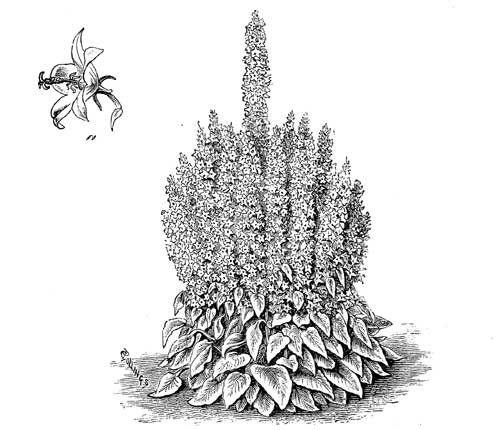
Fig. 23. Campanula Pyramidalis.
(One-twentieth natural size; a, one-half natural size.)
In the borders and shrubbery this is a very effective subject; it is amongst herbaceous plants what the Lombardy poplar is amongst forest trees—tall, elegant, and distinct. Its use, however, is somewhat limited, owing to the stiffness of the stems and the shortness of the flower stalks; but when grown in pots—as it often is—for indoor decoration, it proves useful for standing amongst orange and camellia trees. It has very strong tap roots, and enjoys a deep rich loam. Not only does it look well among trees, but otherwise the partial shade of such quarters seems conducive to finer bloom.
Flowering period, July to October.
C. p. alba is a white flowering variety of the above species; its other points of distinction are its smaller-sized leaves and much paler green colour, by which alone the plants may be easily recognised from the type. This variety may be grown with good effect in pots or the border; it scarcely gets so tall as the blue form, but looks well by the side of it.
The readiest way to increase these plants is to take the young and dwarf growths from the woody crown of the roots, paring off a little of the bark with each. If these are put in sandy loam during the warm growing season and kept shaded for a few days, they will very soon make plenty of roots; this method in no way damages the flowers. Another way is by seed, but seedlings are two years before they bloom.
Campanula Speciosa
Showy Harebell; Nat. Ord. CampanulaceæA comparatively new species, brought from Siberia in 1825, and sometimes called C. glomerata dahurica. It is a good hardy plant, perennial and herbaceous, and one of the earliest to flower. It has a distinct appearance; it nearly resembles C. aggregata, but the latter does not flower until several weeks later. Apart from its likeness to other species of the genus, it is a first-class border flower, having large bells of a fine deep purple colour, and, unlike many of the Harebells, is not over tall, but usually about a foot high, having a neat habit. The flowers are arranged in dense heads, whorl fashion, having very short stalks; they are nearly 2in. long and bell shaped. The leaves (radical) are oval heart-shaped and stalked; those of the stems are sessile; the whole plant is hairy and robust. This is one of the flowers which can hardly be planted out of place in any garden, excepting amongst the rare and very dwarf alpines; it is not only true to its name, "showy," but handsome. It will grow and flower well in the worst soil and needs no sort of care; it would be fine in lines by a shrubbery, and is effective in bold clumps; and though a new kind, it belongs to a race of "old-fashioned" flowers, amongst which it would mix appropriately. Increased by division in autumn.
Flowering period, June and July.
Campanula Waldsteiniana
Nat. Ord. CampanulaceæA rare and distinct alpine species from Carinthia. It proves perfectly hardy in this climate. For the rock garden it is a gem of the first water, its habit being dwarf, dense, and rigid; floriferous as many of the Bellflowers are, I know none to excel this one. As may be observed in the following description, there are not a few distinctive traits about it, which, more or less, go to make it a desirable subject for rare and choice collections.
The flowers are a glistening bluish-lilac, erect, and ¾in. across when fully expanded. The corolla can hardly be said to be bell-shaped, as the five divisions are two-thirds of its depth, which allows it, when full blown, to become nearly flat, and as the segments are equal, sharply cut, and pointed, the flower has a star-like appearance. The little calyx is cup-shaped, angular, and has small, stout, horn-like segments, which are bent downwards. Each flower has a pedicel about 1in. long, which springs from the axils of the main stem leaves; the stems seldom exceed the height of 4in. or 5in., and they are exceedingly fine, thready, as also are the pedicels; they are, moreover, of zigzag form, from node to node. The leaves are ¾in. long, and less than ½in. wide, ovate or nearly cordate, partially folded, and sometimes reflexed at the ends, nearly stalkless, slightly toothed, smooth, of good substance and a peculiar grey-green colour. The foliage for two or three weeks is completely hidden by the large number of flowers, during which time it is a most attractive subject.
I grow it with other dwarf Campanulas in a collection bed, where it compares well with the finest, such as C. pulla, C. muralis, and C. Zoysii, for effectiveness. Having proved it to thrive well in light sandy soil of a vegetable character, I have not tried it otherwise; it enjoys a sunny situation. The site should be well drained; it will endure nothing like stagnant moisture—its peculiar roots would indicate this fact, they are not only tender and fleshy, but thick and of a pith-like nature, and, as I have never been able to gather any seed, and the propagation has to be carried out by root division, there requires to be a careful manipulation of these parts, for not only do they split and break with the least strain, but when so mutilated they are very liable to rot. I have found it by far the better plan to divide this plant after it has begun to grow in March or April, when its fine shining black shoots, which resemble horse hairs in appearance, are about ½in. high. Slugs are fond of this plant; a dressing once a week of sand and soot, when it begins to grow, will keep them off.
Flowering period, July and August.
Centaurea Montana
Mountain Knapweed; Nat. Ord. CompositæThis is an "old-fashioned" and favourite flower. Every one must be familiar with its thistle-like formed flowers; it is sometimes called the large or perennial Cornflower and also the Large Bluebottle. The blue variety has been grown in English gardens since 1596. There are now white and pink coloured varieties, all rampant growers, very hardy and perennial. They are in every way superior to the annual kind, which is so largely grown, the flowers being more than twice the size, and produced two months earlier; the blooming period is maintained until late autumn.
The flowers, as before hinted, are thistle-shaped; the pericline or knob just under the florets is cone-shaped, covered with evenly set and pointed scales, green, edged with a brown margin, set round with short bristle-like teeth. The florets of the outer ring are 1½in. long, tubular half their length, the wider portion being five to seven cut; the centre florets are short and irregular, richly tinted with pink at their bases; the whole flower or ray, when expanded, is 3in. across. They are produced on stems over 2ft. long and of a somewhat procumbent habit, angular and branched near the tops; the leaves are 3in. to 6in. long, lance-shaped, entire and decurrent, giving the stems a winged appearance. They are of a greyish colour—nappy—whence the name Knapweed.
This vigorous species, with its white and pink varieties, may be grown in any kind of soil. It requires plenty of room; a two-year-old plant will form a specimen a yard in diameter under favourable conditions. The effect is good when all the three colours are grown near each other in bold pieces. They yield an unfailing supply of flowers, which are of a very useful type; in fact, the more they are cut the more they seem to bloom, and it is a good plan to cut short half the stems about June. They will (in a week or two) produce new shoots and large flowers in abundance, the gain being flowers of extra size during autumn.
Propagated by division of the roots any time.
Flowering period, June to September.
Centranthus Ruber
Syn. Valeriana Ruber—Red Valerian; Nat. Ord. ValerianaceæThis is a strong and vigorous garden plant, with a somewhat shrubby appearance; it is herbaceous, perennial, and sometimes classed as a British species, therefore hardy; but though its classification among British plants is justifiable, it is only so on the ground of its being a naturalised subject, its original habitats being in the South of Europe. It is a favourite and "old-fashioned" flower, and it fully justifies the estimation in which it is held, the flowers being produced in large bunches of a fine rich colour, which are very durable. Its shrubby habit is not one of its least recommendations; seen at a distance—which it easily can be—it might be taken for a ruby-coloured rhododendron, to which, of course, it has no resemblance when closely inspected. It grows 2ft. high or more.
The flowers are a bright ruby colour, very small, but closely massed in great numbers, borne in corymbs, terminal and much branched; "the calyx-limb, at first revolute, afterwards expanded into a feather-like pappus;" the corolla is tubular, long, slender, and spurred; the segments or petals are small and uneven, both in form and arrangement; the germen is long; anther prominent and large for so small a flower, viz., ¾in. long and hardly ¼in. in diameter. The stems are stout, round, hollow, and glaucous; they are furnished with leaves of various shapes at the nodes, as lance-shaped, long oval, heart-shaped and plain, elliptical and pointed, wavy and notched, and arrow-shaped, lobed, and toothed. The root leaves are mostly ovate, lanceolate, and entire. The whole plant is smooth and glaucous. From the description given, it may readily be seen that when in flower it will be effective—massive heads of ruby flowers topping a shrub-like plant of shining foliage and glaucous hue. It is eminently fitted for lines or borders where other strong growers are admitted. In a cut state the flowers are very useful; they are strongly scented, something like the lilac, with just a suspicion of Valerian in it. I ought not to omit mention of its extra brightness as seen by gaslight—this fact adds much to its value for indoor decoration.
It may be grown in any kind of garden soil, needing nothing at any time in the way of special treatment; but if it is supplied with a little manure it will pay back with interest, in the form of extra-sized bunches and brighter flowers.
C. r. albus is a white-flowering kind of the above; its main points of difference are its paler green foliage, smaller sized corymbs, shorter growth, and rather later season of bloom.
C. r. coccinea is another kind; the specific name is misleading. It is not scarlet, but nearer a rose colour, and when compared with the typical colour it appears much inferior; still, it is a good variety. All the three colours, when grown side by side, are very showy when in bloom.
This species, with its varieties, may be easily propagated by root divisions at any time from late summer to spring; the long fleshy roots should not be broken more than can be helped; every piece with a crown on it will make a flowering plant the first season.
Flowering period, June to September.
Cheiranthus Cheiri
Common Wallflower; Nat. Ord. Cruciferæ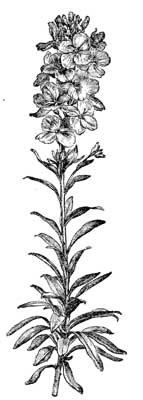
Fig. 24. Chieranthus Cheiri
(One-fourth natural size.)
This well-known evergreen shrub (see Fig. 24) is more or less hardy in our climate, according to the conditions under which it is grown. Although a native of the South of Europe, it rarely happens, however severe the winter may be in this country, that we are totally deprived of the favourite bouquet of Wallflowers in winter or early spring, while it is equally true that, during the hard weather of one or two recent winters, in numerous gardens every plant was killed. In favourable seasons its blooms are produced throughout winter, but the full blow comes in April. Three hundred years ago it was known by its present name; in this respect it is a rare exception, as most flowers have many and widely different names, especially the "old-fashioned" sorts, so that often the varied nomenclature hinders the identification of the species. At one time the Wallflower was called the "Gillyflower," but the name is now only applied to a biennial and single-flowered variety of the stock—a near relation of the Wallflower. More than 200 years ago Parkinson wrote, "Those Wallflowers that, carrying beautiful flowers, are the delights and ornaments of a garden of pleasure."
Of its well-known beauties, as regards its form, colour, varieties, and delicious perfume, description is needless, though I may say, in passing, that its fragrance renders it of value to those whose olfactory nerve is dead to the scent of most other flowers.
Two errors are frequently committed in planting the Wallflower; first, at the wrong time, when it is nearly a full-grown specimen and showing its flowers; next, in the wrong way, as in rows or dotted about. It should be transplanted from the seed beds when small, in summer or early autumn, and not in ones and twos, but in bold and irregular groups of scores together; anything like lines or designs seems out of harmony with this semi-wildling. There is another and very easy method which I should like to mention, as a suggestion—that of naturalisation; let those near ruins, quarries, and railway embankments and cuttings, generously scatter some seed thereon during the spring showers, when the air is still; in such dry situations this flower proves more hardy than in many gardens. Moreover, they serve to show it to advantage, either alone or in connection with other shrubs, as the whin, which flowers at the same time; here, too, it would be comparatively safe from being "grubbed up."
Flowering period, January to June.
Cheiranthus Marshallii
Marshall's Wallflower; Nat. Ord. CruciferæA distinct and very hardy hybrid, being shrubby and tree-like in shape, but withal very dwarf. From the compact habit, abundance and long duration of its flowers, it is well suited for showy borders or lines. It is not yet well known, but its qualities are such that there can be no wonder at its quickly coming to the front where known.
It differs from the common Wallflower in being more dwarf and horizontally branched, while the leaves are more bent back, hairy, and toothed; immediately below the floriferous part of the stem the leaves are more crowded, the stems more angular, the flowers much less, not so straggling, and of a dark orange colour. Other hybrids in the same way are being produced, differing mostly in the colour of the flowers, as lemon, greenish-yellow, copper, and so on.







